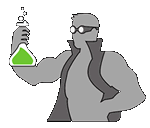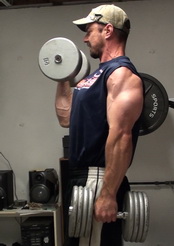As an overview, what we're going to do with this technique is what basically amounts to a "non-stop" set for 10, 20, 30 or even 40 minutes of negative-focused squats. How long you go will depend on how crazy you are (just saying). I did 30 minutes of this in the demo.
And the reason I have "non-stop" in quotation marks is that while you're technically not stopping in terms of how the method is performed, you don't get zero rest (you'll see). You'll get rest during the time it takes to change weights.
Each rep is going to be a "self-resetting" negative where you perform a heavy negative, strip some weight off, then perform a bottom-start Anderson squat off the rails with the lighter weight to get the back back into position for the next negative rep.
The FIRST key is you're not going to stop...for 30 minutes (or however long you decide to do it). You're just going to keep cycling through this sequence of negative, strip weight, squat up, reload, negative.
The SECOND key is that when you get to the point where can't fully control the negative at the very bottom, you're going to reduce the weight that you're using on the negatives and keep going (this the "descending" part of the name). This is what's going to allow you to get to the 20, 30 and 40 minute mark.
You will definitely need a squat rack for this one.
Step 1 - Work up to about 95% of your 1 rep max.
You can do this however you like in terms of weights, sets and rep ranges (e.g. 135 x 10, 225 x 5, 275 x 2, 315 x 1...that kind of thing).
I worked up to a single with 335 lbs. Think of this as a warm-up for what's to come. It's going to prepare your body for exactly what you're going to be doing with the negatives and it will also give you a gauge of what weight you need to use.
Step 2 - Load your working weight.
Once you hit that single with your 95% 1 RM, add 5-10% more weight to the bar. I added another 20 pounds bringing the total to 355 lbs.
The trick here is you want to add some bigger weight to the OUTSIDE of the load. This will make it much easier to strip weight and put it back on.
So using my example, I've got 355 lbs of the bar total. I've got 265 lbs (two 45's and two 10's) on the bar THEN I've got a 45 lb plate outside of that. When I finish the negative, I'll remove the outside 45's, then squat up the 265 lbs from the bottom, then put the 45's back on.
I also recommend setting the safety rails up one notch from a deep squat level (parallel or a little above). This will give you good range of motion on the way down and allow enough space for you to get yourself back under the bar once you unload it.

Step 3 - Perform the negative
The first half of the descent is going to be relatively normal. You're stronger in this range so you won't actually be performing a true eccentric/negative yet. Just lower the weight under control...until you get closer to the bottom.

THAT is when we really start making use of the super-maximal load.
When you get just below about halfway to 2/3 of the way down, start TRYING to push back up. The weight should be such that it's too heavy for you to actually squat back up with it.
Keep trying...
The speed of the rep should slow down a lot here as you actively FIGHT the descent of the heavy load. This is not just about controlling the negative...you have to fight it to get the most out of it.
The key gauge I like to use for this is sound.
When you finally get to the bottom and set the bar on the rails, the bar should make barely any sound at all. If the weight drops with a loud clang, you either didn't fight the negative all the way to the bottom or the weight is too heavy.
The analogy I like to use gives you a great visual...it like a self-closing drawer that goes most of the way in at a regular speed then very slowly closes at the very end.

Step 4 - Unload some weight off the bar.
This is where having a pair of 45's on the ends is handy. Take those off the bar and set them aside.


Now you've got 90 lbs less on the bar and it should be light enough that you can bottom-start squat it up. It won't be easy, but it will be doable...and it will give you some great work out of the bottom in a "normal" way, in addition to the negative work.

Step 5 - Reload the bar
Put the 45's back on.


Then get back under the bar and repeat. This entire process takes a little over a minute to cycle through. You don't have to be in a hurry to do it, but just keep moving.
Now the fun begins...
Step 6 - Descending weight
You're going to keep using your original working weight until you get to the point where you start to drop too fast at the bottom of the rep...where you start to make some noise. This indicates you can no longer control the weight for the full range of the top and it's time to reduce the load.
Take about 5-10% off the weight. I reduced the load to 335 lbs, taking 20 pounds off.
I reached this point about 10 minutes in.


Then keep going.
Step 7 - Do it again
If you again get to the point with this lighter weight that you start to drop, reduce the weight again. I hit this about 20 minutes in, reducing the working weight to 315 lbs, where I stayed for the rest of the time.


Step 8 - Burn out
This is an optional finisher you can do once you hit the end of your designated time.
Take the light weight you finished with (after stripping the 90's off on the last rep) and do as many bottom-start squats as you can.
Then take more weight off and burn out again, basically doing a drop set.
You don't necessarily HAVE to do this, but I really found it to be effective, especially for improving the mind-muscle connection of the squat. You can really focus and feel the target muscles contracting.
THEN you're done.
Overall, this is a fantastic way to strongly overload your squats, developing strength as well as confidence under the bar.
---
Are you 40...50...60 or even 70+ years old and want to build muscle and strength like you did 20 years ago?
If you feel like you're fighting a losing battle, you're ready to discover the REAL secret to REVERSING muscle loss due to aging...
*** You need to train the body systems that SUPPORT your muscle mass, not just the muscle itself. ***
These underlying support systems diminish as you age, which is why you lose muscle as you get older no matter how hard you train... but with strategic training, these systems can be regenerated.
Share This Page...
Want More Strength-Building Techniques and Programs?
You'll find them here...



